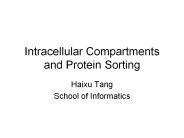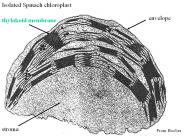Plastid PowerPoint PPT Presentations
All Time
Recommended
The most important are the chloroplasts. ... Polyphyletic (Reptiles) NODE. BRANCH. Phylogeny Estimation. Branch-and-Bound. Least Squares ...
| PowerPoint PPT presentation | free to view
Endosymbiotic origin of mitochondria and plastids Polycistronic mRNAs Prokaryotic like mRNA in plastid Comparison of genome sizes Huge variation in size of ...
| PowerPoint PPT presentation | free to view
Endosymbiotic origin of mitochondria and plastids Polycistronic mRNAs Prokaryotic like mRNA in plastid Comparison of genome sizes Huge variation in size of ...
| PowerPoint PPT presentation | free to view
Sizes of (plastid) cpDNA Range is 70,000 bp (70 kb) to ~2,000,000 bp (2,000 kb), but most are less than 250,000 bp (250 kb) Land plants typically 120 170 kb
| PowerPoint PPT presentation | free to download
Central vacuole in plants is for support and storage of metabolic wastes ... 2. Cell movement the assembly, disassembly, and sliding of microfilaments and ...
| PowerPoint PPT presentation | free to download
Sizes of (plastid) cpDNA ... Sizes of cpDNAs from diverse plants. From ... Rumpho, M.E., Summer, E.J. & Manhart, J.R. (2000) Solar-Powered Sea Slugs. ...
| PowerPoint PPT presentation | free to view
Title: Slide 1 Author: Michelle Last modified by: kumi2la Created Date: 4/16/2004 6:23:50 AM Document presentation format: On-screen Show Other titles
| PowerPoint PPT presentation | free to download
Sizes of cpDNAs from diverse plants. From Kloppstech, Westhof et al. ... ancient algae, such as reds (rhodophytes) or chromophytes (Chl a/c ...
| PowerPoint PPT presentation | free to view
... by appropriate PCR primers, along with other Ct DNA markers ... (1988) TAG 75: 741 ... ( 1988) TAG 76: 172-176. Evolutionary Pathway of T-type Chloroplast ...
| PowerPoint PPT presentation | free to view
A) B) Percentage of genes Biological process Cellular component Molecular function Percentage of genes ER plastid
| PowerPoint PPT presentation | free to download
The major intracellular compartments of an animal cell ... INTRACELLULAR COMPARTMENT. An electron micrograph. Development of plastids ...
| PowerPoint PPT presentation | free to download
Plant plastids. Chloroplast (green ... Leucoplast ('white plastid')- store starch. Chromoplast ('colored plastid')-named for pigments besides chlorophyll i.e. ...
| PowerPoint PPT presentation | free to view
PLANT STRUCTURE AND FUNCTION D Jones Plant Cell Types parenchyma metabolism storage contain plastids that store store starch ...
| PowerPoint PPT presentation | free to download
Plastids. Plastid characteristics. Like mitochondria and nucleus with double membrane ... one of most common plastids. system of membranous stacks thylakoids ...
| PowerPoint PPT presentation | free to view
... mutant with enhanced antioxidants (hp2) - shows enhanced plastid development, and - is defective in a repressors of photomorphogenesis (LsDET1) ...
| PowerPoint PPT presentation | free to download
Cell is the base of life * * Plastids Thylakoids function in the steps of photosynthesis that initially convert light energy to chemical energy Collectively a stack ...
| PowerPoint PPT presentation | free to view
facebook Wall Photos Me Sources Chlory Plastid Logout Chlory Plastid is making energy from sunlight. Wall Info Photos Boxes Write something Share View photos of Chlory
| PowerPoint PPT presentation | free to download
... OASTL isoforms in A. thaliana: cytosolic OAS-A1, plastid OAS-B and mitochondrial OAS-C. The alignment was created with Vector NTI software.
| PowerPoint PPT presentation | free to download
The color of the plant is usually caused by the contents of the plastids. Chloroplasts. A chloroplast is an example of a plastid filled with chlorophyll ...
| PowerPoint PPT presentation | free to view
... Autophagy Central Vacuole Mitochondria Chloroplast (a plastid) Cytoskeleton: Microtubules Organelle Movement Centrioles / Centrisomes Flagella / Cilia ...
| PowerPoint PPT presentation | free to view
Plastid Transcriptional Regulation. Transcriptional regulation is often global or ... Stability of some plastid mRNAs increases during greening (psbA), but most ...
| PowerPoint PPT presentation | free to view
Mitochondria. Meiosis and sex. Plastids. Shared by all eukaryotes. Only some. eukaryotes ... mitochondrion. cyanobacterium. Eukaryote. nucleus. plastid ...
| PowerPoint PPT presentation | free to view
Chloroplasts Belong to the class of organelles known as the plastids. They are the sites for photosynthesis in plant cells and some forms of eukaryotic algae.
| PowerPoint PPT presentation | free to view
Nitrate reductase. Activity appears to be limiting in some cases (more often ... Nitrite reductase. In plastids. Uses reduced ferredoxin as the electron donor ...
| PowerPoint PPT presentation | free to view
A typical eukaryotic cell has a nucleus and membrane bound organelles. ... Chloroplast is one type of plastid, which contains green pigment chlorophyll. ...
| PowerPoint PPT presentation | free to view
Organelles (plastid and mitochondrion) * Gramene Highlights. Species: Rice (Oryza) Maize (Zea) ... CMap allows genetic, physical and sequence maps to be aligned. ...
| PowerPoint PPT presentation | free to view
Scattered vascular bundles (also in Nymphaeaceae, Piperaceae) Sieve cell plastids with several cuneate protein crystals (also in paleoherbs) Adventitious roots ...
| PowerPoint PPT presentation | free to view
ARC6 Is a J-Domain Plastid Division Protein and an Evolutionary Descendant of ... SALRRIQL*AICLDFNKILLGYRIHWLCLLLHLHVIIVSNFTHFSWMLRKERELMGFCGFKL*SSQELSHWFTVA LYV ...
| PowerPoint PPT presentation | free to view
Now used as an informal term Endosymbiosis Organelles were formerly prokaryotes Led to mitochondria and plastids Entered as undigested prey or parasite Mutualism ...
| PowerPoint PPT presentation | free to view
Mitochondria and plastid genomes of plants and protists (rRNA, tRNA and mRNA genes) ... Metazoan mitochondria. Not found in nuclear or viral genes ...
| PowerPoint PPT presentation | free to view
Diatoms can form small colonies, and filaments have been seen to measure over two feet. ... There is a yellow tint that can be seen due to photosynthetic plastids. ...
| PowerPoint PPT presentation | free to download
Cells contain tiny structures that carry on specific functions ... Captures energy from the sun **Plastid seen without stain because are colored by pigments ...
| PowerPoint PPT presentation | free to view
Starch and the sum of Glucose, Fructose and Sucrose are expressed as mole ... Plastid Ribosomal. Proteins. Post-translat. Modification. Supplemental Figure 7A. ...
| PowerPoint PPT presentation | free to download
Mitochondrial RNA Polymerase: A phage-like RNAP. Core enzyme ... They also differentiate. Chloroplasts are only the main form of a class of Organelles: Plastids ...
| PowerPoint PPT presentation | free to view
Tous les tres vivants sont faits de cellules (au moins une cellule) ... wall) cellulosic. Mitochondria. of plastids and membrane (or wall) cellulosic. of ...
| PowerPoint PPT presentation | free to view
Early microscopes in 1590 when glass lenses could be polished. Robert Hooke ... Also called a Plastid. Only found in Plant Cells. Site of Photosynthesis ...
| PowerPoint PPT presentation | free to view
Hypothetical evolutionary reduction of secondary plastids. to give appearance ... (cyanelles) retains aspects of the endosymbiont (unique w/euglyphid amoeba) ...
| PowerPoint PPT presentation | free to view
How do light signals control nuclear genes for leaf & plastid development? Can divide into 3 basic steps (or parts): Receiving the signal (photoreceptors)
| PowerPoint PPT presentation | free to download
For example, the plastids of cryptomonad algae contain ... Secondary plastid. Brown algae, diatoms, Cryptomonads, Euglena etc. The cryptomonad situation ...
| PowerPoint PPT presentation | free to view
Scanning ? Some of the proteins that bind the 5' UTRs of mRNAs promote translation ... expressed poorly if plastids don't develop, or are damaged by photo-oxidation. ...
| PowerPoint PPT presentation | free to view
Use the computer programs described on the next few s to predict the ... Predotar - Prediction of mitochondrial and plastid targeting sequences ...
| PowerPoint PPT presentation | free to view
Some mt & cp proteins contain subunits encoded by organelle s genome
| PowerPoint PPT presentation | free to download
Chloroplast genome: Evolution, structure and regulation of the gene expression Darin I. Peshev Chloroplasts Chloroplasts Development of chloroplasts Development of ...
| PowerPoint PPT presentation | free to view
Carries out photosynthesis. Contains own genome. Believed to be of endosymbiotic origin ... Photosynthesis. Metabolism. The inverted repeat (IR) Ranges from 5bk ...
| PowerPoint PPT presentation | free to download
Assembly, Transport & Storage Other organelles F. Endoplasmic Reticulum Structure = Rough ER Covered in ribosomes Smooth ER No ribosomes Function = Where chemical ...
| PowerPoint PPT presentation | free to view
Some mt & cp proteins contain subunits encoded by organelle s genome Cytoplasmic inheritance first seen as strictly maternally inherited albino variegation no ...
| PowerPoint PPT presentation | free to download
Title: Prokaryotes and Metabolic Diversity Author: Jay Comeaux Last modified by: Kyle Harms Created Date: 2/24/2003 1:26:59 PM Document presentation format
| PowerPoint PPT presentation | free to view
Isolated Spinach chloroplast envelope thylakoid membrane stroma From Hoober Chloroplast RNA polymerases (RNAPs) Two different RNAPs in vascular plant chloroplasts ...
| PowerPoint PPT presentation | free to download
Chapter 4 : Cells Cell Discovery 1. Robert Hooke 1664 saw 1st cell and named it a cell. 2. Schleiden, Schwann, and Virchow - made up cell theory.
| PowerPoint PPT presentation | free to download
THE PROTISTS The dilemma Systematists have split protists into many kingdoms. Originally grouped as mostly unicellular eukaryotes Problem: Paraphyletic grouping ...
| PowerPoint PPT presentation | free to view
Title: Dr Joanne Chory of The Salk Institute, Howard Hughes Medical Institute will be presenting a seminar on
| PowerPoint PPT presentation | free to download
Space - MIDDLE LAMELLA - filled by PECTINS. Communication ... Middle lamella. Animals: Gap junctions. heart muscle cells example. Animals: Adhesion of cells: ...
| PowerPoint PPT presentation | free to view
... Cell Growth and Development - apical meristems, cell division, expansion and differentiation. ... to in vitro procedures and applications; secondary ...
| PowerPoint PPT presentation | free to view
VII. Cell Parts Dissecting the cell Quick Definitions Homeostasis is the process of maintaining the cell s environment. Selective permeability is the process where ...
| PowerPoint PPT presentation | free to view
Protist diversity I Level 1 Biological Diversity Jim Provan Diversity of protists In Whittaker s five-kingdom system, eukaryotes were divided into four of the five ...
| PowerPoint PPT presentation | free to view
Structure of plant mitochondria. Bean. 10. BIOL. 350 Spring 08 ... Plant mitochondria contain additional enzymes (in green), which do not pump protons. ...
| PowerPoint PPT presentation | free to view
























































